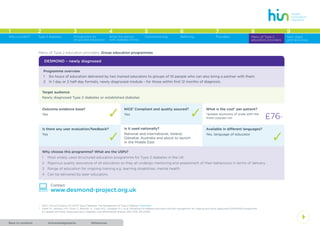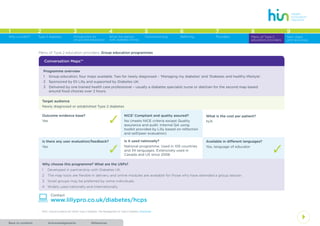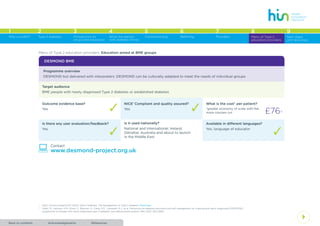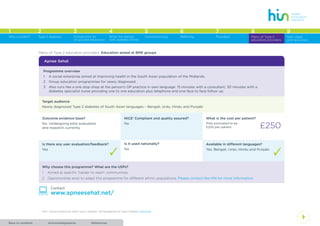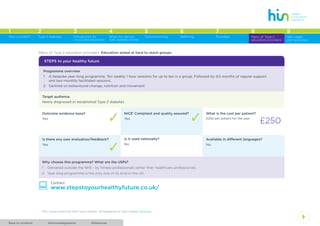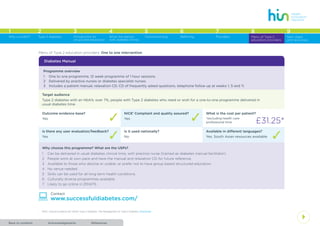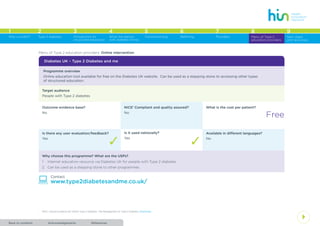This document provides an introduction to a toolkit for structured education for Type 2 diabetes. It discusses the low uptake of structured education programs despite recommendations and incentives. The toolkit aims to address causes of low uptake and provide guidance to commissioners, providers, and referrers to ensure accessible high-quality structured education. It summarizes the national and local burden of diabetes, costs of complications, and recommends increasing attendance at education to save £1.7 million per CCG annually. Common structured education programs are introduced.
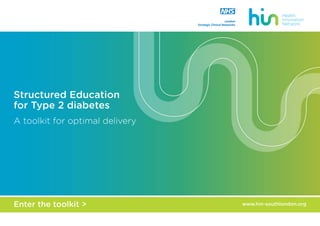

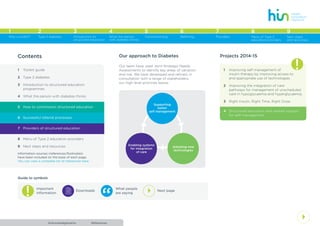


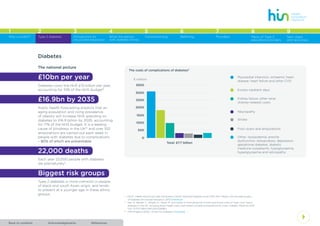
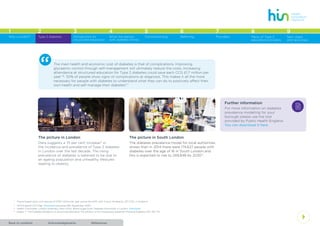

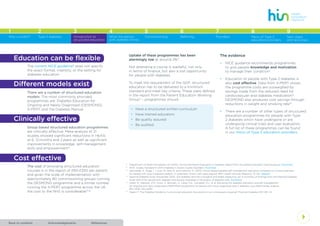



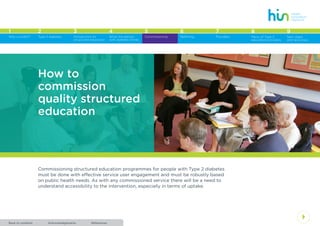




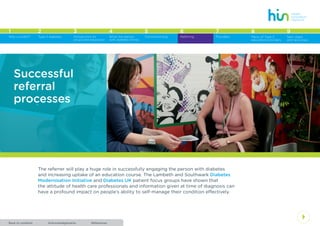
![AcknowledgementsBack to contents References
4
1 2 3 4 5 6 7 8
Type 2 diabetes Introduction to
structured education
What the person
with diabetes thinks
Commissioning Referring Providers Menu of Type 2
education providers
Why a toolkit?
9
Next steps
and resources
Successful referral processes
“ I think my doctor failed me by
not mentioning the DESMOND.
Remove barriers? Just give out more
information.”
“ I heard about it [DESMOND] but not
told about it directly [from health
professional]. I don’t know about the
[the benefits of the] programme so
I can’t decide.”
Whilst most people are likely to be referred by a
practice/ community nurse or GP, there should be
opportunity for people to self-refer as people’s
readiness to learn/change can vary.
!The following information is highly
recommended for discussion with
patients when referring:
• Need to emphasise that structured
education is an integral part of diabetes
‘treatment’
• Give details of what the structured
education course covers and the benefits
of the course
• Show them the next available dates and
venues
• Explain to them the referral pathway
and who they will be hearing from next
regarding this
• Direct them to trusted and reliable sites of
information which they can read/watch for
more information on Type 2 diabetes.
If you require any documents supporting the
above, your structured education provider
can provide them upon request or the Health
Innovation Network can make them available.
A number of other innovations
can be considered:
• Encouraging GPs and practice nurses to
attend ‘taster’ sessions for structured education
• Providing skills training in motivational
interviewing.
The Quality and Outcomes Framework for
General Practice 2014/5 provides a financial
incentive for GPs to refer patients to structured
education within 9 months of diagnosis.
This encourages referral but provides no
encouragement to attend such courses.](https://image.slidesharecdn.com/e7518889-bcbc-4321-81e0-2083b898796d-150813195224-lva1-app6892/85/diabetes_toolkit_web-19-320.jpg)
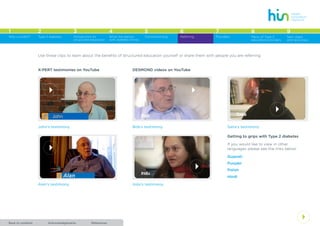



![AcknowledgementsBack to contents References
4
1 2 3 4 5 6 7 8
Type 2 diabetes Introduction to
structured education
What the person
with diabetes thinks
Commissioning Referring Providers Menu of Type 2
education providers
Why a toolkit?
9
Next steps
and resources
Systematic engagement and
feedback from service users
Structured education services should routinely
take account of the service user’s views on delivery
and accessibility.
Services, which have undertaken and acted
on patient feedback, have seen a significant
improvement in patient attendance rates.
The network strongly recommends the inclusion
of a patient feedback system as part of the service
specification.
Providers should routinely collect course
satisfaction questionnaires from all attendees and
report the findings, with remedial action plans via
their internal quality and governance process and
local commissioning leads.
“ I think I prefer one to one, I don’t think
I prefer the group at all…I think it is erm,
you know, you in a group of strangers
with people you’ve never met before.
I don’t think I’ll like it.”
“ I didn’t tell anybody [family, friends,
including partner]. I keep it to myself.
I don’t want it [diabetes]…. I don’t
want to go [to the DESMOND course]
because I might see someone I know.”
Electronic Administration Systems
Electronic patient administration systems and
formal databases should be used by teams to:
• Effectively manage all referrals in a timely
fashion
• Effectively use their resources by improving
course utilisation, and ensuring courses run
with maximised attendance
• Provide a systemic and easily accessible
recording system enabling patients to have
maximum choice as to time and location of
appointment
• Support effective integration of care and
transfer of information in a timely fashion from
referral to discharge
• Systematically and routinely identify all patients
who declined the opportunity to attend before
or after booking on a course, enabling the
service provider and GP to take timely action
and follow up
• Enable easy access to a database to assess
service performance
• Provide ‘hot and cold spots’ referrer data to all
the referrers (e.g. scorecard) on a routine basis
to ensure they see the results of their referrals
and have the opportunity to make them more
effective if necessary.](https://image.slidesharecdn.com/e7518889-bcbc-4321-81e0-2083b898796d-150813195224-lva1-app6892/85/diabetes_toolkit_web-24-320.jpg)

